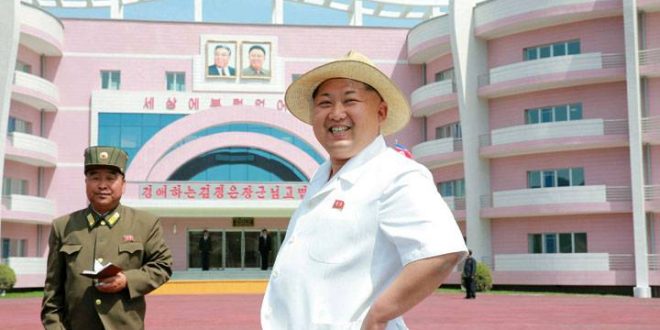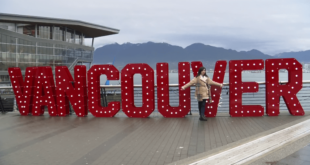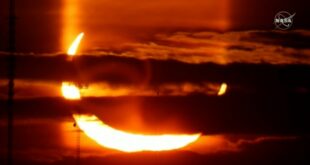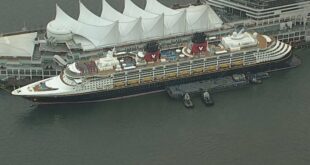SEOUL, Oct 10 (Reuters) – In the seaside city of Wonsan, North Korean families cook up barbecues on the beach, go fishing, and eat royal jelly flavored ice cream in the summer breeze. For their leader Kim Jong Un, the resort is a summer retreat, a future temple to tourism, and a good place to test missiles.
He is rebuilding the city of 360,000 people and wants to turn it into a billion-dollar tourist hotspot. At the same time, he has launched nearly 40 missiles from the area, as part of his accelerated tests of North Korea’s nuclear deterrent.
“It may sound crazy to outsiders to fire missiles from a place he wants to develop economically, but that’s how Kim Jong Un runs his country,” said Lim Eul-chul, an expert on the North Korean economy at Kyungnam University in South Korea.
This combination of tourism and nuclear weapons is emblematic of Kim Jong Un’s strategy for survival, say researchers and people familiar with the project.
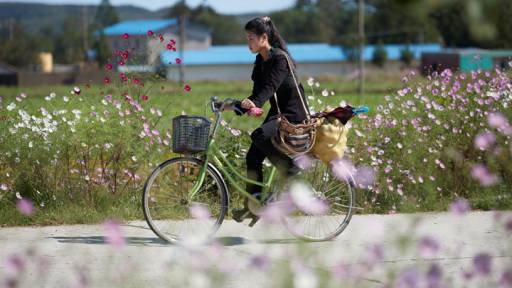
A girl carrying goods cycles past wild flowers near the North Korean town of Wonsan October, 2016.
Christian Peterson-Clausen/Handout via REUTERS
North Korea’s development plans for Wonsan have mushroomed since they were first announced in 2014. Examined here in detail for the first time, they run across 160 pages in nearly 30 brochures produced by the Wonsan Zone Development Corporation in Korean, Chinese, Russian and English in 2015 and 2016.
Tourism is one of a shrinking range of North Korean cash sources not targeted by United Nations sanctions, and the brochures advertise to foreign investors some $1.5 billion worth of potential ventures in the Wonsan Special Tourist Zone, an area covering more than 400 square km (150 square miles). Kim has already constructed a ski resort and a new airport there.
According to one brochure, the Zone includes approximately 140 historical relics, 10 sand beaches, 680 tourist attractions, four mineral springs, several bathing resorts and natural lakes and “more than 3.3 million tons of mud with therapeutic properties for neuralgia and colitis.”
The projects that Kim is inviting investors to help build include a $7.3 million department store, a $197 million city center development, and a $123 million golf course (including a $62.5 million fee to lease the land).
Earlier this year Kim sent 16 of his officials to Spain to get ideas for Wonsan. They visited Marina d’Or, one of the Mediterranean country’s biggest holiday complexes, and the Terra Mitica (Mythical Land) theme park in Benidorm. Terra Mitica caters to fans “of extreme sensations,” according to its website.
“They saw such places with their own eyes and filmed some of them,” said a spokesman at the North Korean embassy in Madrid. Both parks confirmed the visits; a spokeswoman for Terra Mitica said the North Koreans were impressed by its themes including the ancient civilizations of Egypt, Greece and Rome.
No major foreign partner has said they will back Kim’s Wonsan projects. The new airport, completed in 2015, has yet to open to international flights. America recently banned its citizens from visiting North Korea. International sanctions now ban all joint ventures with the state.
Even so, the plan is strategically vital for Kim, say former North Korean diplomats. When he came to power in 2011, he inherited a society officially run by the military but whose people survived largely on black market dealings. On paper, North Korea is a state-run economy; but in fact, seven in 10 North Koreans depend on private trade to live, according to Thae Yong Ho, North Korea’s former deputy ambassador in London, who staged a high-profile defection with his family in 2016.
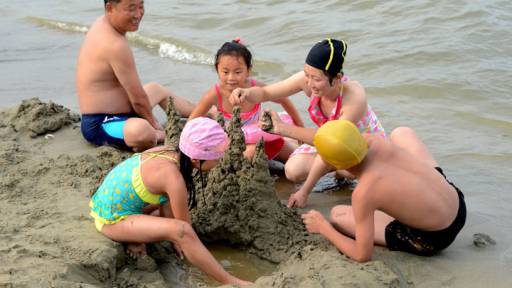
A family builds a sandcastle at Songdowon International Children’s Camp in Wonsan City in this undated photo released by KCNA.
KCNA/via REUTERS
Kim is perceived by outsiders as all powerful, but North Korea’s free marketeers make him more vulnerable than he seems, Thae told Reuters. The leader is looking for a way to harness both military and market forces to survive.
Nuclear weapons are one part of his answer – because Kim hopes they will cost less to maintain than North Korea’s conventional heavy weapons. Projects like Wonsan are the other part. He wants to cut the share of funding he gives to the military and allocate more money to the civilian economy.
“Kim Jong Un knows that he can only control society and guarantee his long leadership if his role and influence in the economy is increased,” said Thae.
“Friendly towards tourists”
North Korea wants to attract more than 1 million tourists every year in the near term and around 5 million to 10 million tourists “in the foreseeable future,” the Wonsan brochures say. The Wonsan Zone Development Corporation, the North Korean state body which oversees the project, did not respond to requests for comment.
There are no up-to-date statistics on current visitors to North Korea. China said more than 237,000 Chinese visited in 2012 but it stopped publishing the statistics in 2013. For comparison, 8 million Chinese visited South Korea in 2016.
The Korea Maritime Institute, a think-tank in the South, estimates that tourism generates about $44 million in annual revenue for North Korea – about 0.8 percent of the country’s GDP. About 80 percent of all North Korea’s foreign tourists are Chinese, it says. Westerners and Russians make up the rest.
The Wonsan brochures are welcoming.
“Officials and residents of this zone have a good understanding of tourism and are friendly towards tourists,” one says.
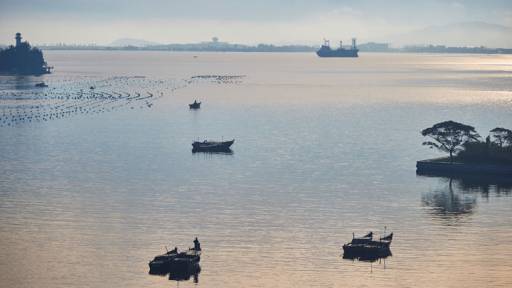
The Bay of Wonsan is seen from a hotel room in this October, 2016 photo in Wonsan, North Korea.
Christian Peterson-Clausen/Handout
The brochures also disclose some unusual details about vacation habits in the totalitarian state.
Not far from the proposed $123 million golf course, the plans show an existing compound. It is labeled in the brochure as the summer retreat of the State Security Department or “Bowibu” – the entity which runs North Korea’s six prison camps and conducts nationwide surveillance of ordinary citizens.
Just next door to that beachfront property, the Daesong General Bureau – the body also known as “Office 39” that procures luxury goods for the Kim family – has its retreat.
A third compound is reserved for the Korean National Insurance Corporation, a state insurance company that the European Union says is involved in insurance fraud.
All three entities are subject to international sanctions because of their role in funneling cash into Kim’s nuclear and missile programs.
For Kim’s security forces, though, Wonsan is about more than fun in the sun.
Kim brought his top military brass to Wonsan in 2014. On the white sandy beach of his palace compound, he ordered his highest admirals to strip into bathing costumes and, as a test of their ability, swim 10 km around the bay, state TV showed. It filmed him at a desk on the sand, shaded by a white parasol.
In April this year, Kim used the beach near Wonsan’s new airport to unleash an artillery drill described by state media as the country’s largest ever. In it, “300 large-caliber self-propelled guns” opened fire at a white target painted on a small island 3 km away.
The bombardment, broadcast on state TV, turned that island into a dusty moonscape.
Plastic flower offerings
Wonsan holds symbolic power for the Kim dynasty: It was there that Kim Jong Un’s grandfather Kim Il Sung, who helped found North Korea at the end of Japanese colonial rule in 1945, first landed with Soviet troops to take over the country.
Statues of North Korea’s two former leaders stand on the quayside, where tourists are expected to bow and buy plastic flowers to offer them. Next door to the Kim family palace, the Songdowon Children’s Camp has welcomed “Young Pioneers” from Soviet-backed countries for decades, according to state media.
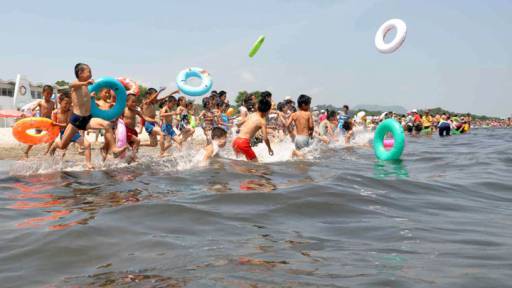
Schoolchildren play in the water at Songdowon International Children’s Camp in Wonsan City, North Korea in this undated photo released by KCNA.
KCNA/via REUTERS
When the young Kim was picked as heir to Kim Jong Il in 2009, he had few achievements to his name, noted Kim Young-Hui, who heads a team of North Korea researchers at Korea Development Bank in Seoul. If he can develop Wonsan – the place where his grandfather helped bring North Korea into existence – it will seal his image as a master builder.
“He has strong political reasons to develop Wonsan,” she said. She is a native of the city and defected to South Korea in 2002.
People from Wonsan, even those who have defected, say they have largely happy memories of the place. Wonsan’s karaoke bars and billiard clubs have a more reliable supply of electricity than much of North Korea, they say. They recall young couples roller skating in a big square near the Wonsan waterfront.
The city has a special place in Kim’s heart, says Michael Spavor, a Canadian consultant who shared Long Island Iced Teas with Kim on board one of his private boats in 2013, after they had been jet-skiing in the bay.
“He told me about … redeveloping and improving the whole city for the people and … attracting international tourists and businessmen to the area,” said Spavor, who runs the Paektu Cultural Exchange, which conducts economic research in North Korea.
“No belt-tightening”
Official history has not disclosed Kim’s birthplace, but many people from Wonsan believe he was born there, partly because he spent his early years at the palace.
An anecdote from that time gives a flavor of life inside the Kim family residence. One day, the Japanese family chef, Kenji Fujimoto, recounted in his memoirs, the future leader made an unusual remark.
“Hey, Fujimoto!” a young Kim said to the chef.
“We ride horses every day, go rollerblading, play basketball, and in the summer we jet ski or play in the pool. But how do ordinary people live?”
Fujimoto, who published the book in 2010, now runs a sushi restaurant in Pyongyang and could not be reached.
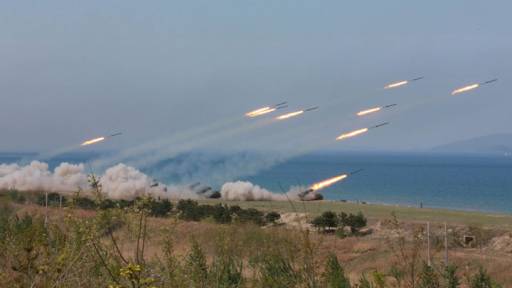
A military drill marking the 85th anniversary of the establishment of the Korean People’s Army (KPA) is seen in this handout photo by North Korea’s Korean Central News Agency (KCNA) made available on April 26, 2017.
KCNA/Handout via REUTERS/File Photo
For years under Kim Jong Il, North Korea, backed by the Soviet Union and China, had officially provided everything for its people.
The political model then was known as “songun” – military first, which held that the Korean People’s Army was the first in line for resources and the infallible provider to fix the country’s economic problems. The “million-man army” would swap Kalashnikovs for shovels and set to work building roads, dams and housing.
After the Soviet Union collapsed in the 1990s, the entire nation, then 21 million people, suffered a famine that Kim Jong Il was eventually to call the “Arduous March.” The state was no longer able to provide food, or work. Between 200,000 and three million people died.
To survive, ordinary people were forced to look beyond the marshaled ranks on display at parades, and hustle for scraps on private markets, bribing officials to turn a blind eye to any illegality. For most people – including the military – it was hunger or trade.
When Kim the younger came to power, he said the time had come to “enable our people… to live without tightening their belts any longer.”
In 2013, he shifted the political rhetoric. His policy line, called “byungjin” or parallel development, harked back to his grandfather’s era. It also signaled the side-by-side advance of North Korea’s nuclear deterrent and a strong economy.
Making money in Wonsan
The latest available figures say North Korea spends a bigger share of its GDP on the military than any country in the world – an average of 23 percent between 2004 and 2014, according to the U.S. State Department.
The Wonsan brochures promise healthy profits, including internal rates of return of between 14 percent and 43 percent. The $7.3 million Wonsan Department Store, for example, allows for foreign investors to hold a stake of up to 61.3 percent. In return, it says, investors can expect to make $1.3 million net annual profit.
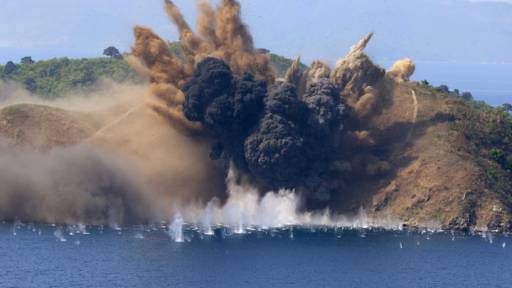
A target island off the coast of the Kalma International Airport in Wonsan, North Korea, is hit during a live-fire artillery drill August, 26 2017.
KCNA/via REUTERS
The brochures offer preferential conditions for foreign investors, saying their rights are protected by the state and they can remit funds abroad without any limitations. Land is available to them to lease, not to own, for 50 years, but investors can trade the leases.
Some of the projects are less generous. One offers the opportunity to cash in on the popularity of North Korean beer with an initial $2.4 million investment in a new Wonsan Brewery. The proposal says foreign investors will be subject to a 15 percent transaction tax, a city management tax, an auto tax, plus other deductions. Then there is income tax at 14 percent. These deductions will nearly halve the projected annual profit, to $154,711.
For domestic investors North Korea officially has no tax, but experts say the state raises funds by collecting about 70 percent of the profits of state enterprises.
A few of the proposals stretch the idea of tourism. They include an Offshore Farm to produce seafoods “of great economic value on an industrial basis, so as to satisfy the demands of tourists and export the products to the foreign market,” a lighting factory, a furniture factory, and a renovated Wonsan Fishing Tackle factory. Its output will include 10,000 deep sea floats, 750 tonnes of ropes and 2,500 “lifesaving jackets for swimming.”
Since the plans were drawn up, the United Nations has tightened sanctions on North Korea to include a ban on seafood exports and curbs on joint ventures.
According to a brochure from 2015, foreign investor interest in the Wonsan project was “growing day by day.”
But a Westerner who attended an investment conference in Wonsan in 2015 said North Korean officials showed little understanding of investors’ needs. About 200 people, Chinese and Westerners, heard about investment prospects in the zone and were taken on a tour of the area.
“I thought I might be a witness to some actual pragmatism,” said Simon Cockerell of Beijing-based Koryo Tours. “But they simply went on about how amazing the opportunities were and couldn’t admit any weaknesses or that there may be any issues at all with the area or any of their plans.”
Han Jin-myung, a North Korean diplomat who was stationed in Vietnam until 2015 before defecting to South Korea, said he had been tasked with promoting the Wonsan scheme abroad and had little success: “We just ended up selling North Korean herbs and medicines instead.”
(Reporting by Ju-min Park and James Pearson in Seoul; Additional reporting by Seung-Woo Yeom in Seoul and Sonya Dowsett in Madrid; Edited by Sara Ledwith)
[ad_2]You can read more of the news on source
 Travelsmart
Travelsmart
